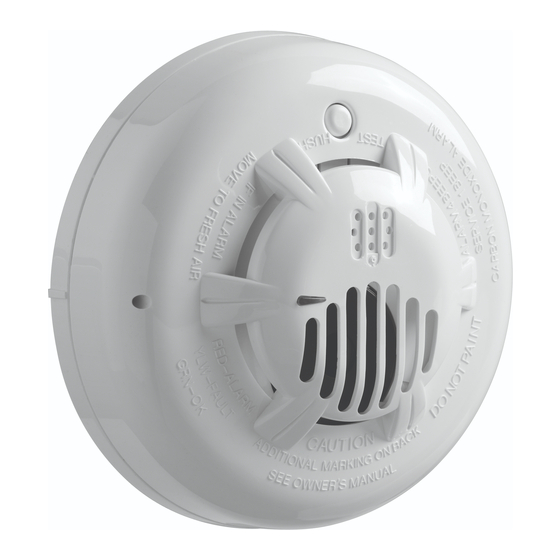DSC PG9933 Инструкции по монтажу и эксплуатации для монтажника - Страница 2
Просмотреть онлайн или скачать pdf Инструкции по монтажу и эксплуатации для монтажника для Датчики безопасности DSC PG9933. DSC PG9933 9 страниц. 915mhz wireless carbon monoxide detector

Installation Instructions
Battery Installation
To replace the battery:
1. Remove the detector from its mounting base by twisting it counterclockwise.
Remove and dispose of the battery according to your local regulations.
2. To ensure proper power-down sequence, wait a minimum of 20 seconds before
installing the new battery.
3. Install a new, 3-volt CR123A Panasonic lithium battery in the battery com-
partment observing correct polarity. If the battery is incorrectly inserted, remove
gently with a flathead screwdriver and correctly reinsert.
4. Reinstall the detector onto the mounting bracket by turning it clockwise.
5. After the power-up sequence, the green LED blinks once every 12 seconds to
indicate normal operation. If the battery is not installed correctly, the detector
will not operate and the battery may be damaged.
Enrollment
The 7- digit serial number located on the back of the CO detector housing must be
enrolled on the alarm systems control panel. See the Receiver Installation Manual and
follow the enrollment procedure. For placement tests remove the detector from its
backplate for one second (tamper) and then reattach. Wait at least 30 seconds for the
test result before activating again.
A general description of the procedure is provided in the following flow chart:
Step Procedure
1
See the Installation Manual for the alarm system that the device is being
enrolled on to ensure that the proper steps are used.
2
Enter the Device Enrollment option through the specified method and select the
appropriate option to add the new device.
3
Enroll the device by inserting the batteries to power up the device and enter the
Device ID. For example, ID No. 222-XXXX.
4
Select the desired Zone Number.
5
Configure any device parameters that are required. Enter the DEV
SETTINGS menu and select the required options to configure the detector.
6
Mount and test the detector. See Testing the CO detector for information on
testing the device. In addition, see the alarm systems Installation Manual that
the device is enrolled on for other test procedures that are required.
Selecting a Location
Selecting a suitable location is critical for the CO detector. The Consumer Product
Safety Commission (CPSC) recommends to use at least one CO detector per house-
hold, located as near as possible to sleeping areas of the home, because the human
body is most vulnerable to the effects of CO gas during sleeping hours.
Figure 2: CO Detector Placement
For added protection, install additional CO detectors in every bedroom and on every
level of your home. If your bedroom hallway is longer than 14 meters (40 feet), install
a CO detector at BOTH ends of the hallway. Install an additional detector 6 meters
(20 feet) away from the furnace or fuel burning heat source. For maximum protection,
the detector should also be located outside primary sleeping areas or at each level of
your home. Mount the detector on a firm wall or ceiling.
DO NOT install CO detectors:
In locations where temperature may be below 0 ºC (14 ºF) or above 40 ºC (104 ºF).
l
In locations where humidity is below 10% or above 93% RH non-condensing.
l
Near paint thinner fumes.
l
Near air conditioners, furnaces, stoves, fireplaces and any other ventilation source
l
that may interfere with CO gas entering the detector.
In locations where furniture or draperies may obstruct the air flow.
l
In exhaust streams from gas engines, vents, flues or chimneys.
l
Where dirt or dust could collect and block the sensor and prevent it from working.
l
In locations that can be reached by children.
l
In turbulent air from ceiling fans.
l
In close proximity to an automobile exhaust pipe - this will damage the detector.
l
Legend
A: Bedroom
B: Living Room
C: Kitchen
D: Basement
E: Garage
